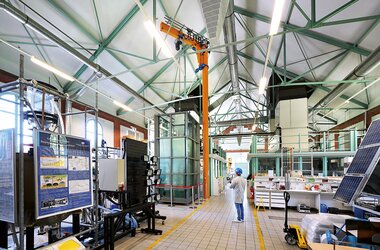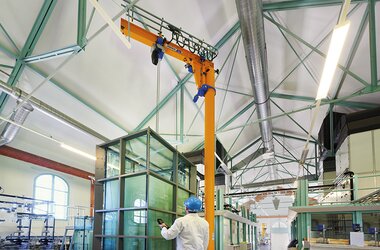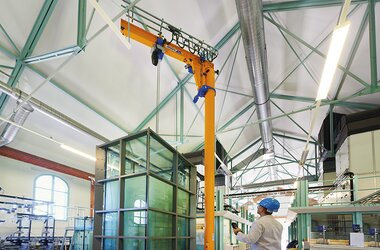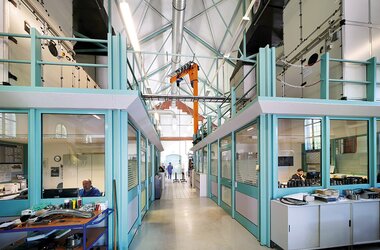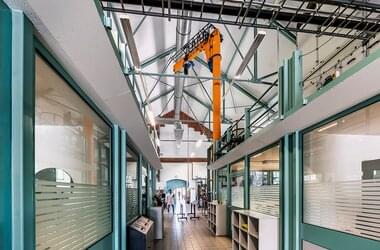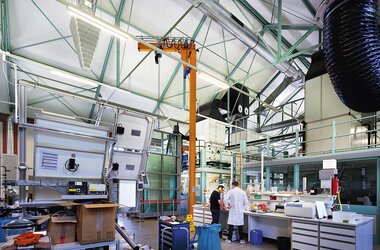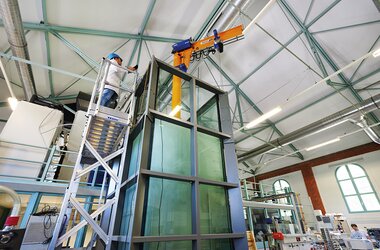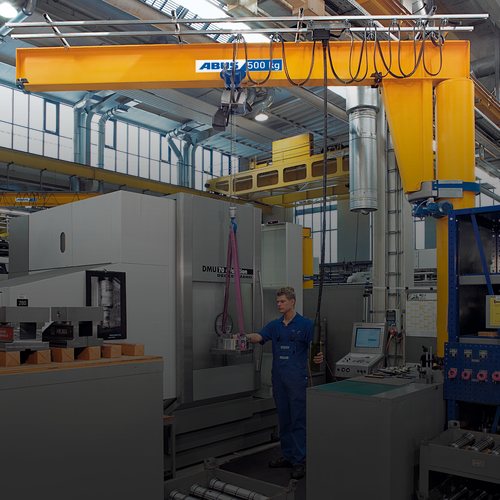ABUS jib crane in the service of science and innovation
The view from a height of over 9 metres extends downwards into a pool of water 5 metres deep. Yet no skilful diver is waiting to show off his somersaults and twists before elegantly entering the water without a splash. This large pool—containing 12,000 l of liquid and weighing 17 t—in the laboratory for process technology at the University of Osnabrück (a city in the federal state of Lower Saxony in north-west Germany) is much rather destined to be used by having a membrane module inserted into it for research purposes. The glass walls of the pool are 4 cm thick and, according to professor doctor Frank Helmus, the laboratory director, are able to withstand the impact of a lorry.
High tech for the water and wastewater industry
These membrane modules constitute an innovative means of wastewater treatment in particular in such cases when extremely high demands are made on the hygienic quality of the water. The laboratory for process technology at the University of Osnabrück has been researching the mechanisms of wastewater purification for many years. Prof. Dr. Frank Helmus and Prof. Dr. Sandra Rosenberger together with their team have been working in this endeavour in close cooperation with their industrial and municipal partners. One of these partners, the company MICRON-NADIR (www.microdyn-nadir.com) in Wiesbaden, has made available to the laboratory special major equipment for their research operations.
MICRON-NADIR, a company with about 400 staff in seven countries, has been cooperating with the university for ten years. The membrane bioreactor technology is to be expanded in the context of this cooperation. The company has now made this large pool available to the laboratory for process technology for five years in order for the laboratory to carry out the research on the company’s behalf.
It is not only the size of the pool that makes it special but much rather the contents of the water basin: it is filled with a particular sewage sludge replacement that behaves like sewage sludge but is completely clear. This replacement medium optimised by the research team of the University of Osnabrück allows a close study of the currents in the pool. *
Sensitive lifting from a great height
These studies require the membrane modules to be lifted into the pool with great precision and carefulness. An ABUS jib crane of the VS type is used for this task with a height of 9.83 metres. The jib arm, by contrast, measures only 2.76 metres. The jib crane is equipped with an electric chain hoist type GM4 with a lifting capacity of 1,000 kilograms. This largest design of the ABUS pillar jib cranes may be used with maximum safe working loads of up to 6.3 tonnes and, depending on the SWL, with jib arm lengths of up to 10 metres. Jib cranes with load capacities of up to 4 tonnes are fitted with ABUS electric chain hoists whereas larger capacities will see ABUS wire rope hoists installed. All VS jib cranes have operating radii of 360 degrees. The operating radius may be restricted by so called mechanical slewing stops if necessary. These slewing stops may be screwed on and repositioned in intervals of 15 degrees. The slewing range may thus be adjusted between 0 and 255 degrees. For the present application two slewing stops were fitted.
It is not only the height of almost 10 metres that is special about this crane: all electrical movements of this crane, i.e. lifting, hoist travelling, and slewing are all fitted with a frequency converter ABUliner. Thanks to the frequency converter control the acceleration of speeds is infinitely variable and any selected speed can be maintained. The ABUliner thus guarantees particularly sensitive lifting, slewing, and moving of the load and is perfectly suited to position the load in exactly the required spot. The crane is operated manually via the control unit of the crane which in this case is a radio remote control.
The crane is fixed to the floor of the plant via a dowel plate. This mounting system uses composite anchors specially developed for dynamic loads which are fully sunk into the round dowel plate during installation.
Prof. Helmus, usually lecturing his students at university, has become a student himself again in order to gain his crane operating licence so that he can operate this tall jib crane appropriately. Training for a crane operating licence is part of the ABUS range of seminars on offer. The training itself is composed of theoretical and practical parts which can be carried out at the customer’s premises or in the ABUS seminar rooms.
* Information on the use of the large pool and on the company MICRON-NADIR was extracted from the official press release of the University of Osnabrück released on the occasion of the inauguration of the large pool.

